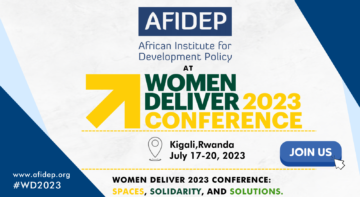Actualités

On 20 June 2018, the African Institute for Development Policy, together with the University of Southampton (UK), the East African Research Fund (EARF), and the United Kingdom Department for International Development (DFID), led other stakeholders working in health, population and development in launching the findings of a study that examined the changing demographics of youth and the increasing demand for social services in four East African Community (EAC) countries: Kenya, Tanzania, Uganda and Rwanda.
The report, titled East African Regional Analysis of Youth Demographics, presents findings of a year-long study on the socio-economic implications of youth demographics in the EAC countries. The report also provides recommendations to the governments of the four East African countries, as well as to the development partners that work to improve the socio-economic situation in the region. These recommendations consolidate evidence from reviewed literature, data, and scenario models, and highlight the policy and programme implications for each of the four countries, and for the EAC region as a whole, to benefit from the potential of their large youthful populations.
Held at the Movenpick Hotel in Nairobi, the launch gave particular focus to the youth demographics in Kenya, and was presided over by Dr. Josephine Kibaru-Mbae, the Director General of the National Council for Population and Development. It also convened representatives from the Kenya government’s ministries and departments, youth groups, civil society, academia and development agencies.
Indicators not improving fast enough, but there’s progress
Speaking at the launch, Dr. Kibaru-Mbae acknowledged that the government has made crucial investments in youth development such as in education; health, including sexual and reproductive health; the empowerment of women and girls; the creation of jobs, among others. As a result, the gains from these investments are evident, for example, in the reduction of birth rates; the improvement in literacy levels; and more girls attaining post-secondary education, among other positive indicators. However, she admitted that these indicators are not improving fast enough to where the progress can meet both national and global commitments that Kenya has made. She contended that while investments are being made, they might not be adequate and as such the allocations to the priority areas would need to be improved going forward.
Further, Dr. Kibaru-Mbae urged all the partners working on the demographic dividend agenda in Kenya to engage from the national blueprint « Vision 2030, in order for their efforts to culminate in a better quality of life for all of Kenyans. She also pressed on the importance of the development needs and priorities at the county level to be incorporated into national development plans in order to maximise the demographic dividend earned.
Youth as active participants of their development
While giving her remarks on the study, Mrs. Susan Njau, the Director of Youth Affairs Directorate at the Ministry of Public Affairs, Youth and Gender Affairs, urged young people to take a more active role in the demographic dividend agenda as opposed to having it largely driven by development partners in the region. In doing so, she believes this will create opportunities for collaboration with the youth as allies in agenda setting, making them agents of their own development.
Mrs. Njau, however, noted that conversations on the demographic dividend should consider the various religious and cultural aspects of the Kenyan population. This applies more so in demystifying the demographic dividend in rural and far-flung areas and marginalised communities, as they tend to favour their indigenous norms over and above conventional wisdom and practice. A good example is comprehensive sexuality education (CSE), whose introduction and mainstreaming in the Kenya basic education curriculum has been a thorny issue and has been fiercely opposed by various stakeholders, more so religious leaders. Mrs. Njau urged those involved in the development and rolling out of the CSE curriculum to rethink their approach, incorporating how communities discussed sexuality in the traditional African context. This could diminish some of the resistance associated with discussing sexuality in the Kenyan society today and enable the successful implementation of the CSE curriculum.
Call to action
Christine Kolbe, Head of the East Africa Research Hub at DFID, termed the findings of the study a call to action to national governments and development partners in the EAC region. She called on the concerned actors to put in place measures to provide adequate sexual and reproductive health information and services; strengthen governance and accountability in order to improve service delivery; improve access to education; initiate economic reforms to make the region favourable for trade and development. Above all, she hoped that what the study revealed regarding youth demographics in relation to the region’s current and future socio-economic outlook would make it possible for all the stakeholders involved to reflect and seek a new approach to development in East Africa.
In closing, the forum spurred the interest for even further engagement among development actors to make Kenya’s dividend a reality. Dr. Kibaru-Mbae called for more strategic engagement with policymakers to get the key youth investment priorities incorporated in government documents, urging actors to persist until the actions needed have been incorporated in policy documents or legislation, and implemented. Furthermore, Mrs. Njau expressed her desire to have the findings presented to her officers at the Youth Directorate to have them acquaint themselves, to use the evidence in policy and programme formulation and implementation.
Related Posts





